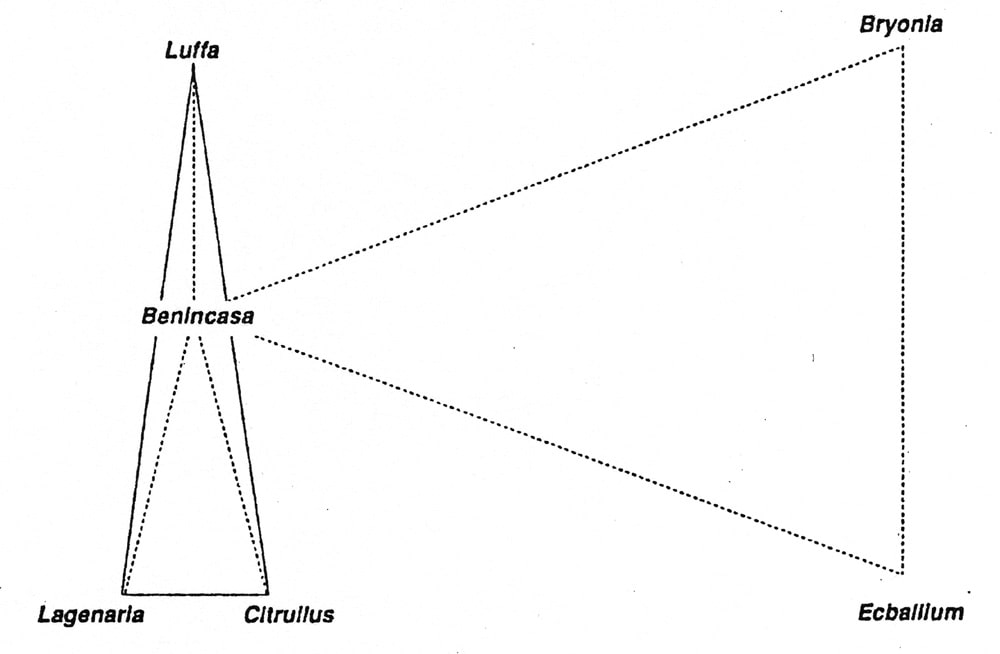Cucurbit Genetics Cooperative Report 12:89-90 (article 37) 1989
D.S. Decker-Walters and T.W. Walters
Department of Botany, University of Guelph, Guelph, Ontario, N1G, 2W1, Canada
We employed starch gel electrophoresis to evaluate allozyme activity and variation in six genera in the tribe Benincaseae (Cucurbitaceae). Germplasm accessions of the domesticated species, Benincasa hispida (Thunb.) Cogn. (winter-melon), Citrullus lanatus (Thunb.) Mats. & Nakai (watermelon), Lagenaria siceraria (Mol.) Standley (bottle gourd), Luffa acutangula (L.) Roxb. (ridged loofah) and Luffa cylindrica (L.) M.J. Roem. (smooth loofah), were obtained from commercial and private sources. Five and fifteen different cultivars of B. hispida and Lagenaria siceraria, respectively, were included in our experiments. The winter-melon cultivars represented the major morphological groupings in the species (2). One bottle gourd cultivar came directly from Niger, Africa, three were from Mexico, and three were from Taiwan. Germplasm representing wild Bryonia dioica Jacq. (bryony), Citrullus colocynthis (L.) Schrad., and Ecballium elaterium (L.) A. Richard (squirting-cucumber) was procured from the Botanical Gardens at Caen and Bordeaux, France. Self pollinations of C. lanatus, Lagenaria siceraria, and both species of Luffa added genetic interpretation of enzyme banding patterns.
Cotyledons of young seedlings provided the electrophoretic sample. We assayed over 40 enzymes using a variety of gel buffer systems. Reasonable scoring was possible for about half of those, including aspartate aminotransferase (AAT), aconitase (ACO), acid phosphatase (ACP), adenylate kinase (ADK), catechol oxidase (CO), glutamate dehydrogenase (GDH), glucose-6-phosphate isomerase (GPI) glycerate dehydrogenase (GD2), glyceraldehyde-3-phosphate dehydrogenase (G3PDH), isocitrate dehydrogenase (IDH), leucine aminopeptidase (LAP), malate dehydrogenase (MDH), ‘malic’ enzyme (ME), menadione reductase (MNR), mannose-6-phosphate isomerase (MPI), peptidase (PEP), phosphogluconate dehydrogenase (PGD), phosphoglucomutase (PGM), and shikimate dehydrogenase (SKDH). Germination difficulties prevented the inclusion of the wild species in the assays of AAT, CO, MNR, MPI, and PEP.
Most species displayed relatively little genetic variation. In spite of morphological diversity, allozyme variation in the winter-melon was limited to ADK, MDH, ME, and SKDH. Polymorphism within and among cultivars of the bottle gourd was detected in ACO, ADK, G6PDH, LAP, ME, PGD, and SKDH. When African and Oriental accessions differed genetically, Mexican cultivars often exhibited both sets of alleles. Although little variation was observed in species of loofah, variation between them was detected in approximately 70% of the scorable enzyme systems. Allozyme variation within and between species of Citrullus was similar to that found in a previous study (1). In our study, ACO nd GDH were additional variable enzymes. Bryony appeared to be the most genetically diverse species; polymorphism was detected in ACO, GDH, GIP, G2D, G3PDH, IDH, MDH, PGM, and SKDH. Variation in the squirting-cucumber could not be properly assessed since few individuals were tested.
Limited variability within species and similarity in band migration among genera provided reasonable justification for attempting generic comparisons. Enzyme systems in which bands from different genera comigrated and homology was assumed included AAT, ADK, CO, GIP, G2D, G3PDH, MDH, ME, MNR, MPI, PEP, PGD, AND PGM. Figure 1 represents our interpretation of genetic relationships as revealed by these generic comparisons. Shorter lines represent a larger proportion of shared allozyme alleles. Bryonia and Ecballium are compared to each other and to the remaining group of genera as a whole.
Figure 1. Allozyme relationships among genera in the Benincaseae.

Literature Cited
- Navot, N. and D. Zamir. 1987. Isozyme and seed protein phylogeny of the genus Citrullus (Cucurbitaceae). Plant Systematics and Evolution 156:61-67.
- Walters, T.W. and D.S. Decker-Walters. 1989. Systematic re-evaluation of Benincasa hispida (Cucurbitaceae). Economic Botany (in press).